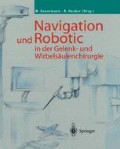Zusammenfassung
Wichtigste Voraussetzung für die dauerhafte Fixation eines Implantats ist die primäre Stabilität. Ziel jeder zementfreien Implantation einer Endoprothese ist die Osseointegration. Darunter wird ein direkter Knochen-Implantat-Kontakt, d. h. eine Fixation des Implantats im Knochen ohne Zwischenschaltung von Bindegewebe verstanden. Neben dem Design des Implantats sowie der Beschaffenheit der Implantatoberfläche und der Materialeigenschaften des Implantats spielt die Operationstechnik für eine dauerhafte Fixation eine entscheidende Rolle. Eine konische Verankerung von Femurprothesen gewährleistet bei zementfreien Implantationen eine hohe Primärstabilität. Die Art der Verankerung des Prothesenschafts in der Femurmarkhöhle und die daraus resultierende Lastübertragung von Implantat auf den Knochen hat somit einen entscheidenden Einfluss auf die Haltbarkeit der Prothese. Um eine möglichst optimale primäre Fixation des Implantats zu erzielen, wird seit Sommer 1994 an der Berufsgenossenschaftlichen Unfallklinik Frankfurt am Main zur Implantation einer Schaftprothese ein computerunterstützter Robotereinsatz verwendet.
Access this chapter
Tax calculation will be finalised at checkout
Purchases are for personal use only
Preview
Unable to display preview. Download preview PDF.
Literatur
Bargar W, Bauer A, Boerner M (1998) primary and revision total hip replacement using the ROBODOC system. Clin Orthop 354:82–91
Bargar WL, Bauer A, DiGioia A, Turner R, Taylor JK, McCarthy J, Mear D (1999) ROBODOC clinical trial status. Center for Orthopaedic Research
Bauer A, Boerner M, Lahmer A (1997) Tierstudie: Roboterassistierte vs. handgeraspelte Endoprothese. Langenbecks Arch Chir I (Forumband 1997): 465–469
Börner M, Wiesel U (1999) Einsatz computerunterstützter Verfahren in der Unfallchirurgie. Trauma Berufskrank 1: 85–90
Börner M, Bauer A, Lahmer A (1997) Computerunterstützter Robotereinsatz in der Hüftendoprothetik. Unfallchirurg 100: 640–645
Börner M, Bauer A, Lahmer A, (1997) Rechnerunterstützter Robotereinsatz in der Hüftendoprothetik. Orthopäde 26: 251–257
Boerner M, Wiesel U, Lahmer A (2000) European experience with an operative robot for revision total hip. Proc Hip Society Meeting, Orlando, FL, March 18th, p 44
Cain P, Kazanzides P, Zuhars J, Mittelstadt B, Paul H (1993) Safety considerations in a surgical Robot. ISA-Paper 93-035: 291–294
DiGioia AM (1998) What is computer assisted and image guided orthopaedic surgery? Clin Orthop 354: 2–4
DiGioia AM, Colgan BD (1997) Robotics, image guidance, and computer assisted orthopaedic surgery. Proc Second Annual North American Program on Computer Assisted Orthopaedic Surgery (CAOS/USA), pp 35–49
Jerosch J, v. Hasselbach C, Filler T, Peuker E, Rahgozar M, Lahmer A (1998) Qualitätssteigerung in der präoperativen Planung und intraoperativen Umsetzung durch die Verwendung von computerassistierten Systemen und Operationsrobotern — eine experimentelle Untersuchung. Chirurg 69: 973–976
Kazanzides P, Mittelstadt B, Musits B, Bargar WL, Zuhars J, Williamson B, Cain PW, Carbone EJ (1995) An integrated system for cementless hip replacement: robotics and medical imaging technology enhance precision surgery. IEEE Engineering in Medicine and Biology, pp 307–313
Lahmer A, Boerner M, Bauer A (1997) Experiences with an image directed workstation (ORTHODOC) for cementless hip peplacement. Proc 11th International Symposium and Exhibition on Computer Assisted Radiology and Surgery (CAR’ 97), pp 939–943
Lahmer A, Bauer A, Hollmann G, Börner M, (1998) Is there a difference between the planning and the real position of the shaft 300 days after a robot assisted total hip replacement? Proc 12th International Symposium and Exhibition on Computer Assisted Radiology and Surgery (CAR’ 98), pp 694–698
Mittelstadt BD, Kazanzides P, Zuhars J, Williamson B, Cain P, Smith F, Bargar W (1994) The evolution of a surgical robot from prototype to human clinical use. Proc First International Symposium on Medical Robotics and Computer Assisted Surgery 1: 36–41
Mittelstadt B, Paul H, Kazanzides P et al. (1993) Development of a surgical robot for cementless total hip replacement. Robotica 11: 553–560
von Loewenich C, Wiesel U, Stuhler T, Müller A (2001) Perioperative Komplikationen bei Primärimplantationen von Hüftendoprothesen-Vergleich von manuellen mit ROBODOC-assistierten Implantationen. Deutscher Orthopädenkongress Berlin 2001
Wiesel U, Lahmer A, Boerner M, Skibbe H (1999) ROBODOC at Berufsgenossenschaftliche Unfallklinik Frankfurt (BGU) — Experiences with the Pinless System. CAS (4) 6: 342
Wiesel U, Lahmer A, Börner M, Skibbe H (1999) Robodoc at Berufsgenossenschaftliche Unfallklinik Frankfurt (BGU) — Experiences with the Pinless System. CAOS/USA ‘99. Third Annual Program on Computer Assisted Orthopaedic Surgery, Pittsburgh, PA, pp 113–117
Wiesel U, Lahmer A, Tenbusch M, Boerner M (2000) Comparison of hand-broached vs. robot-assisted total hip replacement. Proc CAOS/USA Pittsburgh June 2000, pp 171–172
Wiesel U, Boerner M (2001) Does medical robotics influence the implant design in THR? CAOS Espafia 2001, Marbella
Editor information
Editors and Affiliations
Rights and permissions
Copyright information
© 2003 Springer-Verlag Berlin Heidelberg
About this chapter
Cite this chapter
Börner, M., Wiesel, U., Ditzen, W. (2003). Klinische Erfahrungen mit dem ROBODOC-System in der Hüftendoprothetik. In: Konermann, W., Haaker, R. (eds) Navigation und Robotic in der Gelenk- und Wirbelsäulenchirurgie. Springer, Berlin, Heidelberg. https://doi.org/10.1007/978-3-642-55784-2_17
Download citation
DOI: https://doi.org/10.1007/978-3-642-55784-2_17
Publisher Name: Springer, Berlin, Heidelberg
Print ISBN: 978-3-642-62799-6
Online ISBN: 978-3-642-55784-2
eBook Packages: Springer Book Archive

